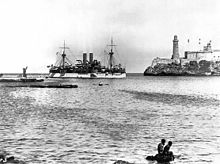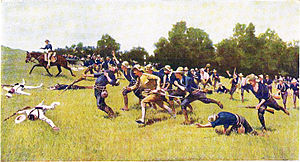Spanish–American War
Spanish-American War
Attack of the Rough Riders at the San Juan Hill, painting by Frederic Sackrider Remington
Spanish-American War
Atlantic Theater of WarPuerto
Rico - Guantánamo Bay - El Caney - San Juan Hill - Santiago de Cuba I - Santiago de Cuba II
Pacific Theater of WarBay of
Manila - Guam - Manila
The Spanish-American War was a military-economic conflict between the United States and the Kingdom of Spain from April 23 to August 12, 1898, ending with the seizure of Cuba, Puerto Rico, Guam, and the Philippines by the United States and signifying the loss of Spain's last significant overseas colonies. The U.S. war aims were to control Spain's overseas territories and to gain access to Asian markets through the Philippines.
The Spanish-American War represents an important turning point in the history of Spain, the history of the United States, the history of Cuba, and the history of the Philippines. For the United States, it represented a first, successful confrontation in the context of its new policy of interests extending beyond the North American mainland and marked the transformation of the Monroe Doctrine from a primarily defensive to an expansionist strategy as an openly imperialist colonial power. Harvard historian John T. Bethell describes the war in this context as a preemptive strike to forestall colonial aspirations of Russia, Germany, and other major European powers in the Far East. For Spain, the defeat meant a farewell to all the restorative attempts of the 19th century to build on earlier colonial greatness. Spain finally sank to a third-rate level in world politics, and the defeat had far-reaching psychological consequences for the country's internal political and cultural fabric. For Cuba, the war marked the conclusion of decades of wars of independence against Spain and, at least formally, its birth as an independent nation, with the country falling seamlessly under the dominance of the United States. In the history of the Philippines it stands for the temporary failure of the independence efforts and the beginning of the conflict with the new colonial power USA.
Prehistory of the war
The Spanish Colonial Empire
Spain had become a major European power after the discovery of America. But already in the 18th century the influence of the Spanish empire waned. After the entire Iberian Peninsula had been subjugated by Napoleon at the beginning of the 19th century, the emerging independence movements reached their goal in almost all of Latin America (see also Simón Bolívar and José de San Martín). What remained were possessions in the Caribbean (especially Cuba), in the Pacific (especially the Philippines) and on the West and North African coasts.
But in these last colonies, too, independence aspirations emerged due to a high and unfair tax burden and a lack of opportunities for the population to participate in politics and administration. The Spain of the Restauración, however, refused to take urgently needed reform steps. In addition, political and economic interests of the USA encouraged the native population to rebel against the colonial power.
US interests in Cuba
The annexation or purchase of Cuba was repeatedly considered by US presidents. After Jefferson and Madison, in 1823 John Quincy Adams also estimated the annexation of Cuba as an indispensable task. In the 1850s, Spain rejected the US proposal to sell Cuba (Ostend Manifesto). Especially politicians of the Southern states were interested in annexing Cuba, another slave-holding state, into the Union before the Civil War. On the other hand, however, racial concerns contradicted the goal of integrating Cuba (where many people of African descent lived) into the United States on an equal footing. This view also influenced U.S. attitudes toward Cuban independence; the administration of U.S. President Cleveland expressed concerns that a Cuban victory could lead to a white and black republic without white supremacy. The Spanish government sought to capitalize on this view, warning the U.S. Secretary of State in a letter regarding the independence movement, "In this revolution, the black (negro) element is the most significant part." The U.S. government viewed both Cuban independence and Spanish rule over Cuba as detrimental to U.S. corporate interests.
But after the USA had completed the consolidation and development of its continental territory in 1890 and the Indian wars had come to an end, the US policy of opening up new markets, also by aggressive means, spread to the remaining overseas possessions of the old world and colonial power Spain.
The Cuban War of Independence 1868-1898
→ Main article: Cuban War of Independence
In Cuba, the landowner Carlos Manuel de Céspedes published the Grito de Yara, the first declaration of independence, in 1868. The Ten Years' War then began, which contributed significantly to the emergence of a Cuban national feeling, but had a devastating effect on the country's economy. In the Peace of Zanjón in 1878, only minor concessions were made to the Cubans, which were perceived as insufficient. The independence movement had thus not been appeased, but rather strengthened. In particular, the writer José Martí advocated the liberation of all Latin America with his essay Nuestra América ("Our America").
Economic problems as well as the unwillingness of the Spanish colonial administration led to a renewed uprising in 1895 under the leadership of Martí, who had founded the Revolutionary Party of Cuba in 1892. He had succeeded in uniting the two main military leaders of the independence movement, Máximo Gómez and Antonio Maceo, to resume the war of independence. José Martí fell in battle and became a national hero. However, the guerrilla war against Spain continued and brought the colonial power to the limits of its economic capacity.
See also: Mambí
Causes and occasion
Since neither Spain nor the independence fighters could bring about a military decision in Cuba, the powerful neighboring state to the north took advantage of the situation to intervene.
In addition, the Asian market had long seemed enticing to the United States as well. The Philippines were of high strategic value, as Manila had become a hub of trade between East Asia and Latin America under the Spanish. The US had already shown clear interest in the Pacific islands of Hawaii (Hawaiian Territory) and Samoa. While interests in the Pacific were not sufficient to persuade the U.S. government to launch a war of aggression against Spain, the conquest of Manila was already part of the U.S. government's war scenarios that had been played out since 1896.
The majority of the US population sympathized with the insurgents in Cuba. The rebellion against a representative of the old world was compared in the press to the US struggle for independence. In contrast, the Spanish-Cuban colonial administration was using force against insurgents, a point emphasized in the U.S. press. Attitudes were more mixed on the question of whether the U.S. should intervene militarily. The Knights of Labor and American Federation of Labor (AFL) unions, for example, supported the uprisings in Cuba. A resolution for U.S. intervention, however, initially suffered defeat within the AFL because of fears of permanent U.S. expansion (replacing Spanish colonialism). Through euphoric media coverage, however, a clearly visible majority developed in favor of a declaration of war, which only the Socialists now opposed by a majority.
President Grover Cleveland stated in December 1896 that the United States would not show indefinite patience toward Spain, and President William McKinley finally elaborated in his Annual Message of 1897 that the United States might be compelled to intervene militarily in view of the continuing Spanish campaign of destruction. In March 1898, several politicians and advisors, including Henry Cabot Lodge, Sr. informed President McKinley that numerous U.S. businessmen were pressing for a quick resolution of the Cuban question due to economic losses. On March 27, 1898, McKinley issued an ultimatum to Spain demanding an armistice.
Against Spanish protests, the U.S. sent a battleship, the USSMaine under Captain Charles Dwight Sigsbee, on a "friendly visit" to Havana Harbor, arriving on January 25, 1898. At the same time, the U.S. fleet was massed at Key West, and preparations were underway for a blockade of the island to cut off Spanish troops from supplies and prevent further reinforcements.
To avoid being branded an aggressor, the Maine's commander forbade the crew to go ashore. However, on February 15, 1898, a devastating explosion occurred on his ship, killing 268 American sailors and soldiers. The United States accused Spain of perpetrating an attack; the American public was expectedly outraged. Publicists William Randolph Hearst and Joseph Pulitzer, among others, stoked sentiment against Spain. The battle cry of the Hearst press was Remember the Maine, to hell with Spain! ("Remember the Maine! To hell with Spain!"), a cause for war had been found. Hearst instructed his correspondent Remington to stay in Havana and supply pictures so that he, Hearst, could supply the war: "You furnish the pictures. I'll furnish the war."
The wreck of the USS Maine has become the subject of much research. Among other things, an investigation in 1976 came to the conclusion that a mine had not detonated under the ship, as claimed by the US government at the time, but that the explosion took place inside the USS Maine. It is possible that an undetected smouldering fire in one of the coal bunkers, which spread to a neighbouring magazine, could have caused the catastrophe (see also coal fire). A recent investigation, in the form of a simulation, by National Geographic Magazine (1999) does not rule out an externally caused mine explosion, without having sufficient evidence to support this hypothesis.
President McKinley, who had initially been opposed to war, under public pressure asked Congress for permission on April 11, 1898, to send troops to Cuba to take action against the Spanish. Mention of the independence question and of rebels as belligerents was cleverly avoided in the request. On April 19, the House and Senate jointly passed a Joint Resolution calling on Spain to withdraw from Cuba and authorizing President McKinley to use whatever military means were necessary to secure Cuba's independence from Spain. The Teller Amendment, named after Senator Henry M. Teller (Colorado), supplemented the resolution with the condition that the United States not annex Cuba after its independence was gained. This amendment was well received by the Cuban rebels and, despite concerns previously expressed by some rebels that the U.S. government might want to replace Spain's kingdom as colonial master, resulted in U.S. troops being welcomed by the rebels. The decision to interfere in the internal affairs of Spanish Cuba by military means was conveyed to Spain on April 20. Spain then broke off all diplomatic relations with the U.S. and in turn declared war against the U.S. on April 23.

The USS Maine in Havana harbor
Questions and Answers
Q: Which two countries were involved in the Spanish-American War?
A: Spain and the United States.
Q: Why did the Spanish-American War occur?
A: It occurred partly because many people in Cuba wanted to become independent and partly because many Americans wanted their country to get a colonial empire.
Q: What was the outcome of the sea war during the Spanish-American War?
A: Spain lost the sea war and had to give up its colonies of Cuba, the Philippines, Puerto Rico, and Guam.
Q: Which colony did not become a US colony after the Spanish-American War?
A: Cuba did not become a US colony after the war.
Q: When did the Spanish-American War take place?
A: The Spanish-American War took place in 1898.
Q: Why did many people in Cuba want to become independent?
A: Many people in Cuba wanted to become independent from Spain.
Q: Which territories became US colonies after the Spanish-American War?
A: The Philippines, Puerto Rico, and Guam became US colonies after the Spanish-American War.
Search within the encyclopedia
